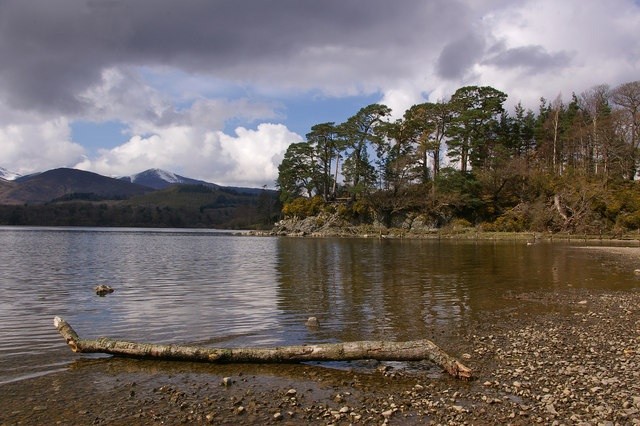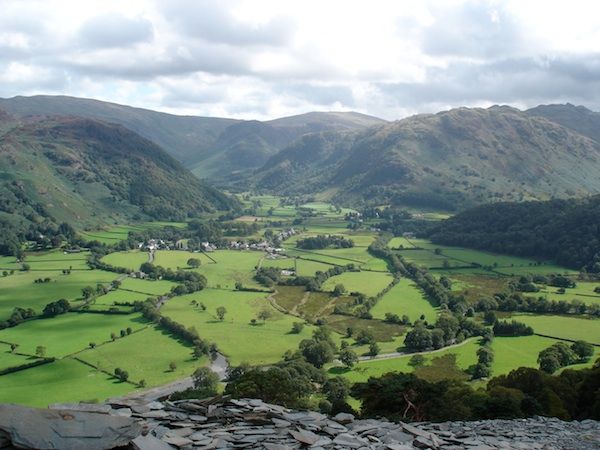The greatness of England’s countryside lies in the understated richness and character that reveals itself as you experience its rustic beauty.
Along the river, out to the promontory, around the Tarn and up to the Crag.
Ladies Walk, Eden Valley Along the river

The first walk is a gentle, 3-mile amble through the fields, woods and humble beauty of the Eden Valley. It focuses attention inwards, introspectively towards the details of the natural world, the wildflowers of spring, the dappled colours of the turning ash trees in the autumn and the pair of whooping swans that frequent the river.
The walk begins in Langwathby and follows the languid meander of the river Eden before winding into a canopy of ash and beech woodland. The path then cuts back on itself, bringing you up into rich open farmland and the attractive and homely village of Edenhall. A small detour can be taken to the serene Pre-Norman church of St Cuthbert. From the vantage point of the village, a great view of the Pennines is offered and, on occasions, the monumental helm bar cloud formation can be witnessed. This rolls over the top of the fells like a great white wave breaking on a mountainous beach. The path then continues back over the fields and towards the river once again.
The walk is best enjoyed early in the morning when the mist is still rising from the sleek calm water of the river and the Salmon, trout and kingfishers are the only movements that break its tranquil surface. Dusk also shares this serenity in a different, but equally atmospheric way. This is the best time to watch for the kingfishers, or if you are lucky, you may even spot the otters playing. The light through the leaves and the fading sun rays over the open fields and the Pennines in the distance creates an encompassing and calm sense of authentic English charm.
Friar’s Crag, Keswick Out to the promontory

This sentiment is also present at Friar’s Crag, a rocky outcrop that juts from the shoreline into the depths of Derwentwater. It is only a short walk, less than a mile long, past the theatre by the lake, and is best undertaken at dusk. The view from the promontory is famed for stargazing, and with the moon reflected in the lake below and the distant Derwent Isle rising from its waters, makes for an unforgettable experience on any night of the year.
John Ruskin regarded the view as one of the three most beautiful scenes in Europe, and another of his opinions is especially relevant to this experience. He believed that ‘There is no such thing as bad weather, only different kinds of good weather.’ This quote is especially true of the conditions of the walk to Friars Crag and the view that it bestows. Even slight changes in the rain, wind, snow or season can create a wealth of changing beauty underneath a lamp of sunlight or starlight. The path crosses a memorial to Ruskin, as well as another built to honour the late Canon Rawnsley, a founder of the National trust. This is appropriate and tasteful, as the area was one of the first pieces of land to pass into the care of the national trust.
Helvellyn Around the Tarn
At 950 Metres (3,117 ft), Helvellyn is the third highest peak in England. The ascent to its summit is an exhilarating hike that takes in the expansive, breathtaking views of the surrounding Eastern fells and Lake Ullswater.
Glenridding is the best place to start for a seven-mile circular walk that involves both Striding and Swirral Edge. This route circles Red Tarn, which is a great place for a swim if you are feeling brave and warmed up from the climb. The best way to ascend to the summit is to cross the exciting striding edge. The well-worn path slightly lower down narrows towards the top at High Spying How, and is well worth the challenge if you possess a steady pair of feet and a head for heights. The grand views from the top are panoramic and never fail to reward the keen walker.
The pinnacle itself is a great plateau and a regal stop for a picnic. To give an indication of scale, this was the first British mountain to have an aeroplane successfully land on its summit. John F. Leeming and Bert Hinkler also took off again into the skies from Helvellyn on the same day in 1926.
Borger Dalr, Borrowdale Up to the Crag

Borger Dalr, which in Old Norse means ‘Valley of the fort’, offers some of the finest views of the entire Lake District. Castle Crag is the best place to witness the surrounding scenery and was described by the famous Wainwright as the “finest square mile in Lakeland”. This four-mile walk is an exceptional example of the particular qualities of this area of England: the rolling fells, patchwork farmland and rich colours that permeate the land. The poignant war memorial at peace how serves as a reminder of the calming effects of the impressive scenery, as it was used as a rest and recuperation area for soldiers returning from World War 1.
The site was also used as a fort over 2,000 years ago, and once you have made the ascent and seen the commanding views, it is easy to understand why. The valley itself was once the bottom of an ice age lake, and it is a peaceful and tranquil place to ponder the historic events that have shaped the area, both geographically and culturally. The vibrantly coloured rock walls at Dalt Quarry feed the imagination further, exposing slices of rich geological history like great slabs of information from the past.
